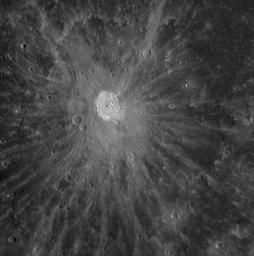
|
Bright Ejecta Rays of Kuiper
- Click the image above for a larger view
- Full-Res JPEG (1018 x 1024) (129.4 kB)
- Full-Res TIFF (1018 x 1024) (1.0 MB)
Caption:
During Monday's flyby of Mercury, MESSENGER's NAC captured a new view of the bright, radial ejecta rays of Kuiper crater that were previously imaged by Mariner 10 at a lower Sun angle. Kuiper crater is named for Gerard Kuiper, a Dutch-American astronomer who was also a member of the Mariner 10 team. Bright ejecta rays such as these are produced as impacts excavate and eject relatively unweathered subsurface material. The ejecta rays of Kuiper and other large craters are observed to extend for hundreds of kilometers across the cratered terrain of Mercury, as seen on the full planet image from MESSENGER's Wide Angle Camera (WAC) released previously ( PIA11245 ).
Date Acquired:
October 6, 2008
Image Mission Elapsed Time (MET):
131774036
Instrument:
Narrow Angle Camera (NAC) of the Mercury Dual Imaging System (MDIS)
Resolution:
530 meters/pixel (0.33 miles/pixel)
Scale:
Kuiper crater is 62 kilometers in diameter (39 miles)
Spacecraft Altitude:
21,000 kilometers (13,000 miles)
Background Info:
These images are from MESSENGER, a NASA Discovery mission to conduct the first orbital study of the innermost planet, Mercury. For information regarding the use of images, see the MESSENGER image use policy .
Cataloging Keywords:
| Name | Value | Additional Values |
|---|---|---|
| Target | Mercury | |
| System | ||
| Target Type | Planet | |
| Mission | MESSENGER | Mariner |
| Instrument Host | MESSENGER | Mariner 10 |
| Host Type | Orbiter | Flyby Spacecraft |
| Instrument | Mercury Dual Imaging System (MDIS) | |
| Detector | Narrow Angle Camera (NAC), Wide Angle Camera (WAC) | |
| Extra Keywords | Crater, Grayscale, Impact | |
| Acquisition Date | ||
| Release Date | 2008-10-09 | |
| Date in Caption | 2008-10-06 | |
| Image Credit | NASA/Johns Hopkins University Applied Physics Laboratory/Carnegie Institution of Washington | |
| Source | photojournal.jpl.nasa.gov/catalog/PIA11355 | |
| Identifier | PIA11355 | |
